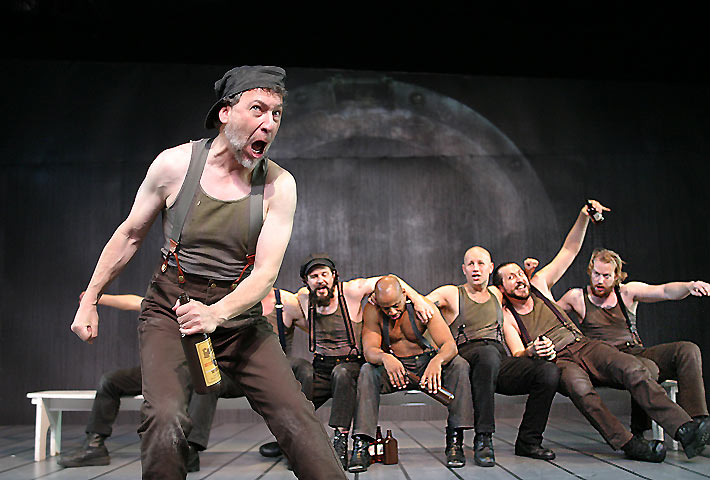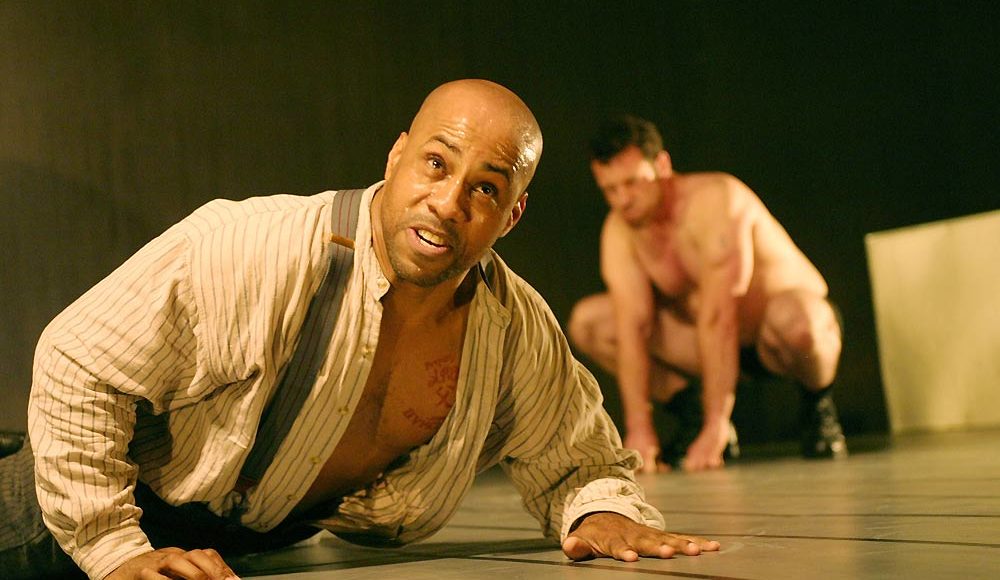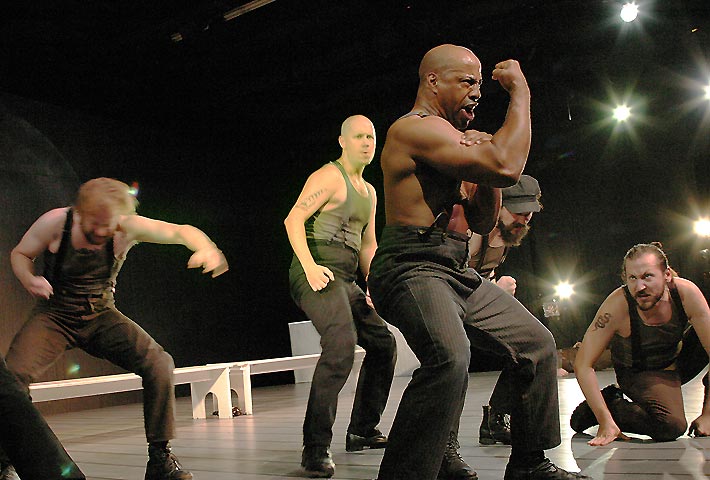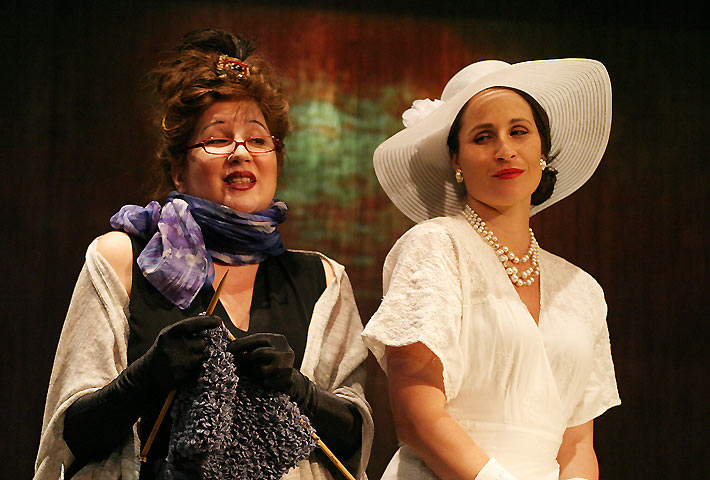The surest way to appreciate Steven Berkoff’s Hairy Ape now playing at the Odyssey Theatre Ensemble is to have acquaintance with Eugene O’Neill’s play of the same name.
O’Neill’s Hairy Ape was first staged in 1922. It falls in what critics and scholars have designated his “second period” which includes All God ‘s Chillun Got Wings, The Emperor Jones, The Great God Brown, Strange Interlude, Days Without End, Mourning Becomes Electra, Lazarus Laughed, and the best known piece from that time-frame Desire Under the Elms.
The Hairy Ape was one of his more experimental works and one that O’Neill stuffed with ideas he wished to investigate. He did not, however, put a great deal of time into the writing of this effort, and, I think, the piece reflects this.
It is, on one level a fascinating hodge-podge of Freud, German Expressionism, the naturalism of Strindberg, Dante’s Divine Comedy, anti-capitalist statements, and Judeo-Christian references, none of which are smoothly blended into a singular mix.
Apparently, O’Neill was aware of this. “I do not think the play as a whole can be fitted into any of the current “isms” he writes:
“It seems to run the whole gamut from extreme naturalism to extreme expressionism – with more of the latter than the former.”
The play is divided into eight scenes.
The first four are shipboard. The next four are off the liner.
Yank (Haile D’Alan) is the “hairy ape” of the title. He is a fireman, not the type that puts out fires on land, but of the breed that stokes them aboard ships. In the bowels of an ocean liner Yank feeds the furnaces that propel the vessel through the ocean.
He is a huge brute, a simple man possessed of an almost animal nature. But in the bowels of the ship, these qualities serve to make him the “top man.” And he exults in this world below deck, in the heat, in the stifling coal dust he inhales, in the back breaking work.
He knows his place in this world, and that place is at the top. And no one can shake Yank’s sense of himself, not Paddy (Dennis Gersten) the old Irishman who longs for the lost days of majestic sailing ships, nor Long (Paul Stanko) the agitator.
But when Mildred (Katy Davis) daughter of the owner of Nazareth Steel; the ship’s builder—who while on a voyage with her aunt (Jennifer Taub)—descends into the ship’s lower level, it is the event that shatters Yank’s world.
There in the depths of the liner, at her first sight of him, Mildred screams “filthy beast” in disgust, then collapses into the arms of an officer.
From this, Yank is plunged into an identity crisis that fuels the rest of the play’s actions, and from here O’Neill presents us with a skewed mirrored version of Dante’s Inferno as Yank leaves the lower levels of Hell to travel up into the sun-lit world, seeking not salvation but revenge.
But the world he finds outside holds neither for him. In fact, it holds nothing for him.
Yank’s “Beatrice” does not guide him from despair to salvation, but through a series of cages. The boiler room of the ship is the first, and from there he goes up into the world thru seven scenes, again mirroring a “looking glass” image of Dante who traveled down the seven levels of Hell.
And while Dante eventually finds release, all Yank finds are cages. Cages of the ship’s interior, of jail and of society, until lastly the cage of a zoo.
Yank is a Caliban on an island populated by Prosperos whose power and magic are all economic. Nor is this Caliban bereft of the power of poetic language:
“Dis ting’s in your inside, but it ain’t your belly. It’s way down—at de bottom. Yuh can’t grab it, and yuh can’t stop it. It moves, and everything moves. It stops and de whole woild stops. Dat’s me now—I don’t tick, see?—I’m a busted Ingersoll, dat’s what. Steel was me, and I owned de woild. Now I ain’t steel, and de woild owns me. Aw, hell! I can’t see–it’s all dark.”
O’Neill’s idiosyncratic dialogue and the structuring of his scenes are layered heavily on, to where most audiences find The Hairy Ape is a difficult play at best.
Director Steven Berkoff is best known to some as an actor in such films as Octopussy, Beverly Hills Cop, A Clockwork Orange, Barry Lyndon and a score of others.
But his passion is the theatre and his approach to the works he has staged is to seek the essence of each drama and damn all the rest. This was obvious in his early work such as Greek, his refashioning of Sophocles’ Oedipus Rex as a love story, and shifting the setting to London’s East End.
He has continued this method in his directing of Oscar Wilde’s Salome and Aesschylus’ Agamemnon, and he has not abandoned that tactic in this production.
If one were being dismissive, one could view Berkoff’s Hairy Ape as a genetic slicing of Bob Fosse and Jane Goodall for he draws from both in structuring of his choreography; emphasizing the subservience of the workers to the machine while instilling in them ape-like behavior.
But one can’t be dismissive of this staging for a single reason:
It works.
Berkoff carves and edits the scenes down, all to the benefit of the production.

Dennis Gersten, Joseph Gilbert, Hailé D’Alan, Benjamin Davies, Anthony Rutowicz, Paul Stanko (Photo by Enci Box)
His cast is wonderfully in sync to Berkoff’s intent, especially D’Alan whose performance and physical presence harkens back to the 1930s production when Paul Robeson became the first African-American to play the title role.
Gersten manages to corral the thorny role of Paddy with flair and Jeremiah O’Brian handles the tricky challenge of “the ape” with simian dexterity as well.
The rest of the ensemble Benjamin Davies, Katy Davis, Joseph Gilbert, Andres Paul Ramacho, Anthony Rutowicz, Paul Stanko and Jennifer
Taub skillfully convey to the stage all the extreme demands Berkoff puts on them.
The play works and works well, because Berkoff casts off everything except what is essential.
O’Neill was aware of what matters in the piece, “The symbol makes the play either important or just another play.”
O’Neill filled this work with thoughts, ideas and images.
Some can be discarded as overplayed, such as the repeated stage direction of Yank assuming the pose of Rodin’s Thinker and in the final scene at the zoo, where the “ape” is found in that same pose.
Some thoughts are hardly discernible to an audience today, as they were, barely, back in 1923.
For example, in the dialogue selection quoted above there is the line, “I’m a busted Ingersoll.”
It’s a toss away, but a potent one.
An “Ingersoll” was a type of industrial drill, only it wasn’t a piece of machinery found onboard steam liners, so what the hell is it doing there?
I believe O’Neill was employing a slanted pun to reference Robert Ingersoll, the American philosopher who was quite prominent in O’Neill’s day, if nearly forgotten in ours.
Ingersoll once wrote:
“What is blasphemy? I will give you a definition; I will give you my thought upon this subject. What is real blasphemy?
To live on the unpaid labor of other men — that is blasphemy.
To enslave your fellow-man, to put chains upon his body — that is blasphemy.”
Within the context of this statement, Yank’s line is given a fuller relevance. And within the context of Berkoff’s direction, O’Neill’s play is as well.
* * *
Executive Director, Ron Sossi and the Odyssey Theatre Ensemble presents
The Hairy Ape
Written by Eugene O’Neill
Directed by Steven Berkoff
Produced by Beth Hogan
Starring Hailé D’Alan, Benjamin Davies, Katy Davis, Dennis Gersten, Joseph Gilbert, Jeremiah O’Brian, Andres Paul Ramacho, Anthony Rutowicz, Paul Stanko, Jennifer Taub
The Hairy Ape runs May 14 – July 17:
• Wednesdays at 8 p.m.: May 25* and June 15 ONLY
• Thursdays at 8 p.m.: June 2; June 9; June 23; June 30 ONLY
• Fridays at 8 p.m.: May 20**, 27, June 3, 10*, 17**; 24; July 1. 8, 15
• Saturdays at 8 p.m.: May 14 (opening night), 21, 28, June 4, 11, 18, 25; July 2, 9, 16
• Sundays at 2 p.m.: May 22, 29, June 5, 12, 19, 26; July 3, 10, 17 (no 2 p.m. matinee on May 15)
* Post-show discussion with the cast scheduled
**The third Friday of every month is wine night at the Odyssey: enjoy complimentary wine and snacks and mingle with the cast after the show.
Odyssey Theatre
2055 S. Sepulveda Blvd.
Los Angeles CA 90025
For Tickets and Additional Information:
• (310) 477-2055 ext. 2 or www.OdysseyTheatre.com






